West Hartford’s Vision Zero Action Plan Nearly Ready for Implementation, Including Immediate Changes

Audio By Carbonatix

A draft of the Vision Zero Action Plan was reviewed with the task force at its last scheduled meeting on Jan. 8, 2024. Photo credit: Ronni Newton
The Town Council’s Community Planning and Economic Development Committee heard a presentation on the updated version of Vision Zero Action Plan.
By Ronni Newton
One of the final steps before the implementation of West Hartford’s Vision Zero Action Plan took place Wednesday morning, when a presentation of the most up-to-date draft of the plan was officially delivered Wednesday morning at a meeting of the Town Council’s Community Planning and Economic Development Committee (CPED).
“We’ve been working on the Vision Zero Action Plan for the better part of a year now,” Town Manager Rick Ledwith said as he introduced several members of the consulting team who, along with Community Services Director Duane Martin, shared the updates with CPED as well as several other Town Council members who attended the virtual meeting.
It’s been just over a year since West Hartford experienced one of the most tragic weeks in the town’s history – when in a period of eight days in December 2022 five people died in town and another was seriously injured as a result of motor vehicle-related incidents. The Vision Zero initiative was launched the following month with the formation of a task force, and with the goal of “zero deaths and zero serious injuries from traffic crashes within 10 years,” which, since the clock started ticking immediately, will be 2033, Ledwith said.
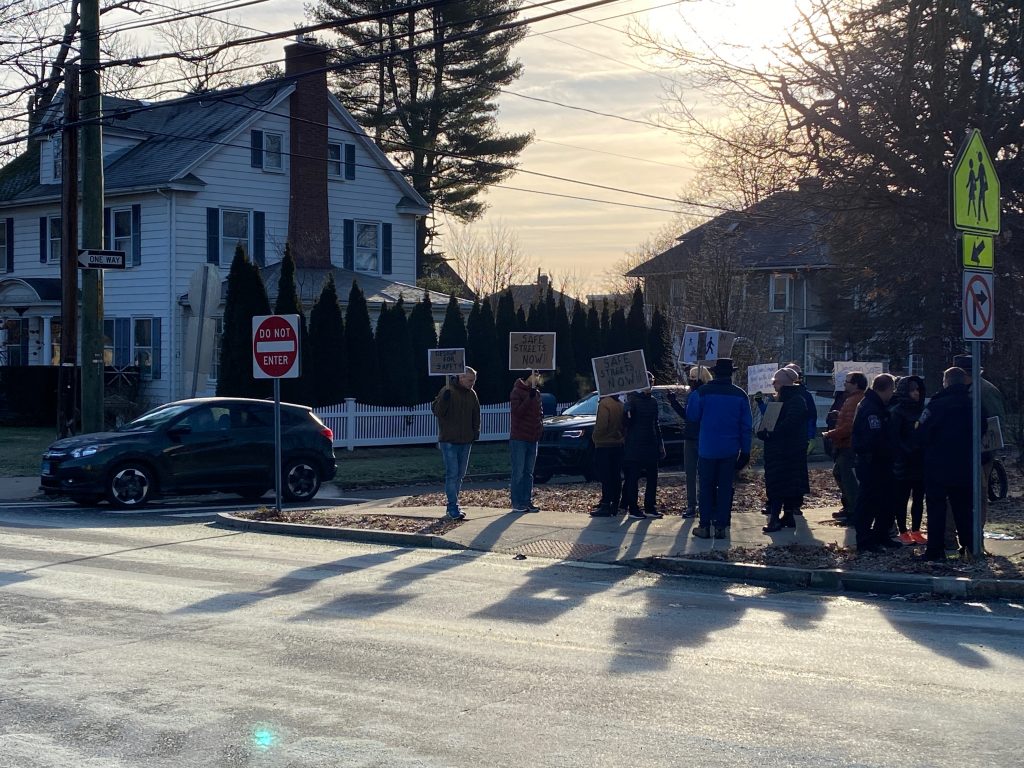
Residents rally for Safe Streets at Boulevard and Whiting Lane on Dec. 21, 2022, where a pedestrian was killed the in a hit and run the previous evening. Photo credit: Doug Hardy (we-ha.com file photo)
Following the tragedies in 2022 there were crashes in 2023 – but nothing like what happened the previous year, and no fatalities. The results will be different for 2024 since just days into the new year, on Jan. 6, 80-year-old David Goldfarb was struck and killed on Albany Avenue near Mohegan Drive.
While the Vision Zero Action Plan has not yet been implemented, one element of the plan has been activated in the aftermath of that fatal crash. One of the 72 items scheduled for implementation within the first year (see more about the planned “quick builds” below) is the convening of a crash response team to examine the factors involved in any serious incident to prevent a recurrence.
Martin said a crash response team of representatives from various town departments – including police, fire, engineering, public works, and public relations – will be meeting this week to discuss the Albany Avenue fatal incident.
Ledwith said among the most critical of the comments received after a review of a draft of the Vision Zero Action Plan first shared at a public meeting on Dec. 6, 2023, was the need to understand and spell out what the “quick build” projects would be – items that could be implemented in 2024 or relatively easily without waiting for a Road Safety Audit (RSA). Formation of a crash response team to conduct quick analysis of any incident is one of the 70-plus items on the list that has been developed by Martin and other staff members.
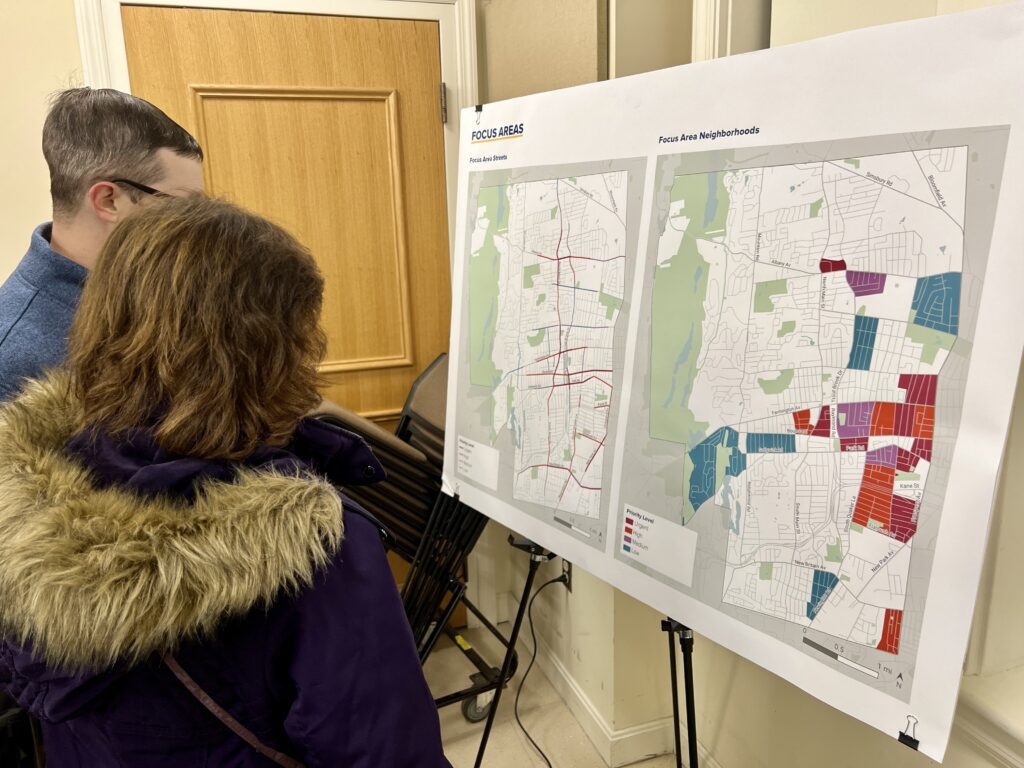
Members of the public review aspects of West Hartford’s Vision Zero Action Plan on Dec. 6, 2023. Photo credit: Ronni Newton (we-ha.com file photo)
“This task force has worked incredibly hard over the last 12 months,” Ledwith said. West Hartford was the second municipality in the state (after Stamford) to adopt Vision Zero, and is working closely with the Capitol Region Council of Governments (CRCOG), which was instrumental in securing a Safe Streets for All (SS4A) grant that will fund speed enforcement cameras as part of the Vision Zero Action Plan. He is hopeful that having the action plan will help the town secure an additional SS4A grant, which has a February application deadline.
Prior to the complete review of the draft, Ledwith noted that getting to this point in the process “is something we can be proud of,” yet in light of the recent fatality, it can be difficult to feel that way. “We are confident that we have a plan to move us forward to create a safe environment here in West Hartford.”
What does the Vision Zero Action Plan include?
Representatives from the consultants that worked with the town on creation of the Vision Zero Action Plan – Parker Sorenson, the project manager from FHI Studio, Shawna Kitzman from Toole Design, and Adam Tecza from FHI – summarized the process for CPED members, and outlined the updates that had been made following the most recent round of public feedback as well as comments made at the Vision Zero Task Force meeting on Jan. 8. Sorensen said development of the plan has truly been a collaborative effort between town staff, the consultants, and the task force.
Kitzman, who led the community engagement process, said there were 15 themes that emerged through feedback from the public via a survey and interactive webmap.
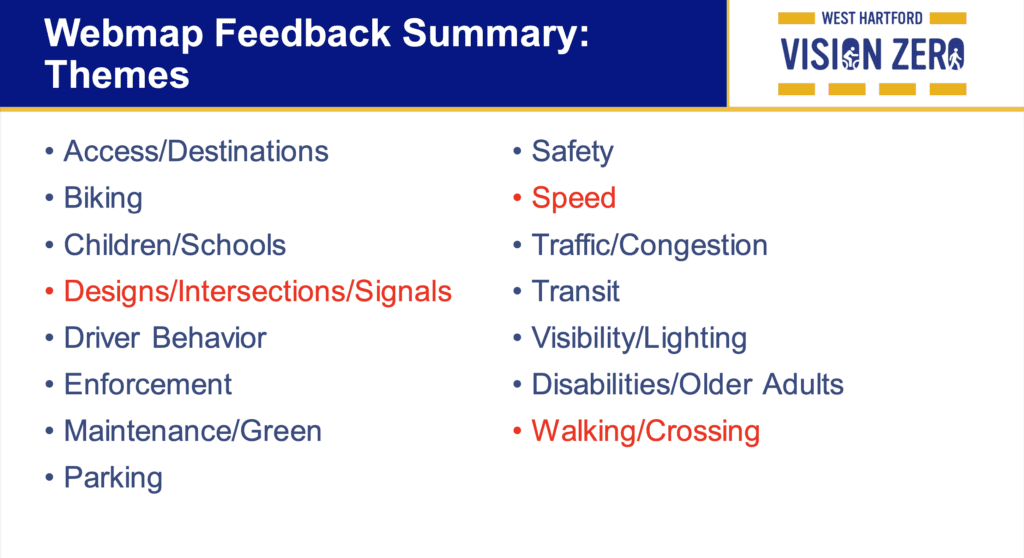
Screenshot
The top three themes that emerged, highlighted in red above, include the design of roadways including intersections and signals, speed, and safety as a pedestrian walking and crossing streets.
Road Safety Audits (RSA) like the one recently completed on Park Road, are intended to identify specific issues in that stretch of a roadway, and brought together town staff from various departments as well as task force members to observe challenges from a hands-on perspective.
The nearly $700,000 SS4A grant will be one way of addressing the speeding issues with speed enforcement cameras to be placed at 15 locations throughout town. Martin and other staff are working with the Connecticut DOT on the data-driven process of determining where those cameras will be located.
Kitzman said at the public forum in December, they heard a lot of specific feedback about individual roadways. Some said the process of implementing Vision Zero was going too fast, while others said it wasn’t fast enough. Some voiced concern about the “strength and viability” of the action plan, “to make sure this plan had teeth,” she said.
There were about 50 comments received in response to the initial draft, many of which have been incorporated into the most current version.
“It may come as no surprise but people in West Hartford are actively engaged and they are concerned about safety,” Kitzman told CPED members. There is excitement about the plan, but also frustration. In addition, many have the perception that the town can change roadways quickly, but that is not the case.
Vision Zero is a holistic solution, Tecza said, outline the stark differences between a conventional approach to road safety vs. the Vision Zero approach the town has chosen. Vision Zero does not seek to prevent all collisions, but rather serious and fatal crashes. It assumes people will not have perfect behavior and therefore is a systemic approach.
Vision Zero is proactive, not reactive, and looks at holistic rather than ad hoc and design-only approaches. It really follows the data, Tecza said, “not just the loudest and most powerful voices.” Creating plans based only on the loudest voices, “traditionally that has not resulted in a reduction of fatalities and serious injuries,” he said.
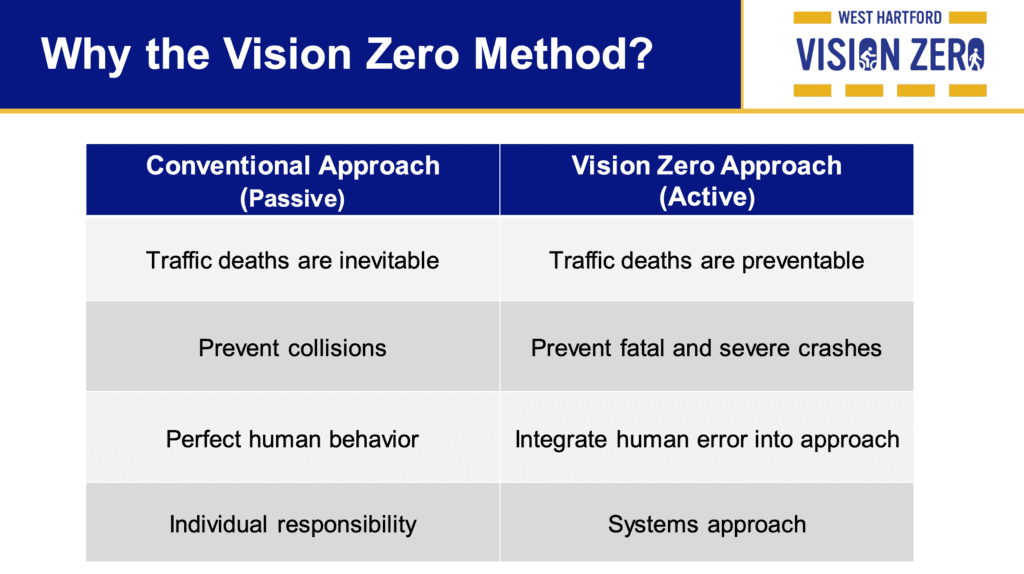
Screenshot
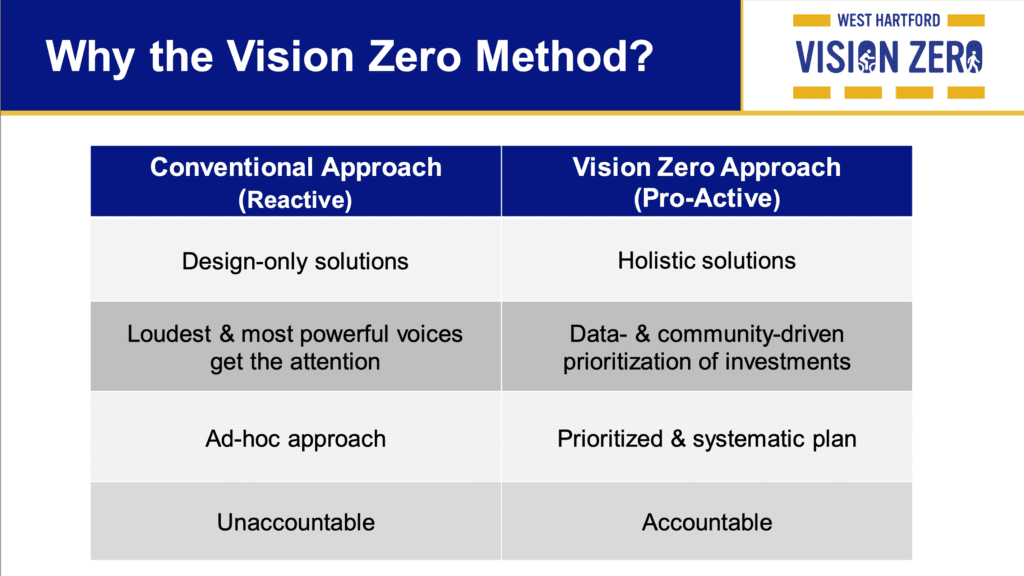
Screenshot
“It’s also data driven,” Tecza said of Vision Zero. And according to their analysis, 56% of fatal or serious injury crashes in West Hartford have occurred on 9% of the roadways.
The consulting team has determined that 7.6 miles within West Hartford will become the initial Vision Zero Focus Areas, “where the town can effectively use its resources to reduce fatalities and serious injuries,” Tecza said. The determination takes into account stretches of roadways where serious crashes have occurred according to data, areas where people perceive the roadway is dangerous, and areas that are also transportation equity zones.
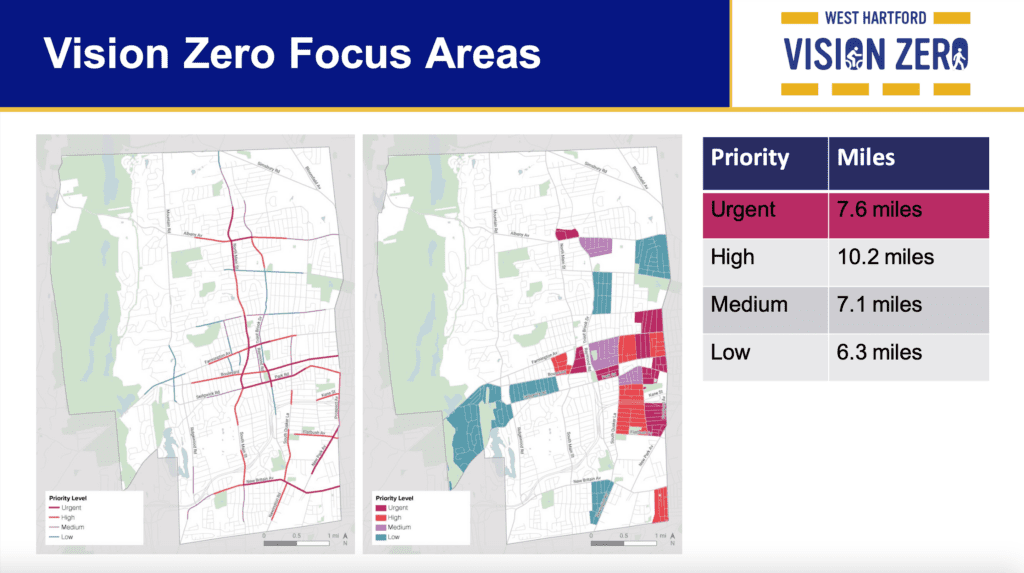
Screenshot
The Action Plan also includes a prioritization of the use of Road Safety Audits. All of the solutions can’t be implemented at the same time, in a reasonable timeframe, Tecza said. “What we have proposed in this plan and think is most productive use of resources …” and the prioritization of the plan also aligns with federal and state approaches for grant funding, he said.
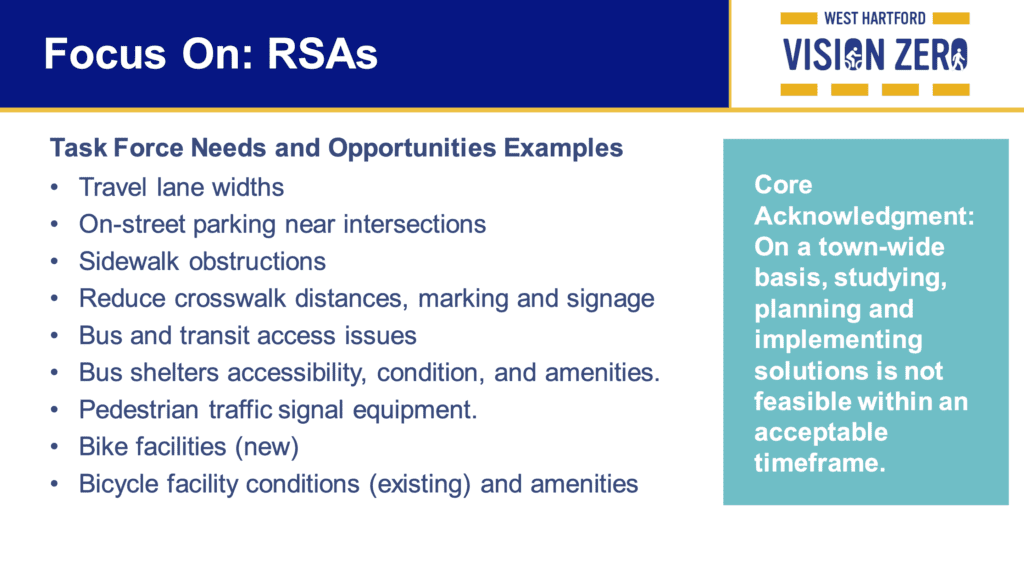
Screenshot
The Action Plan also includes general and specific performance measures, and data dashboard, “SMART” action steps to “move forward with success,” said Tecza.
“We hear loud and clear when there is a serious injury or fatality … when an action plan is being developed, it can feel incredibly disheartening,” he said. “You have made a lot of progress. You are set up for implementation,” he told CPED members, so that these improvements can be made.
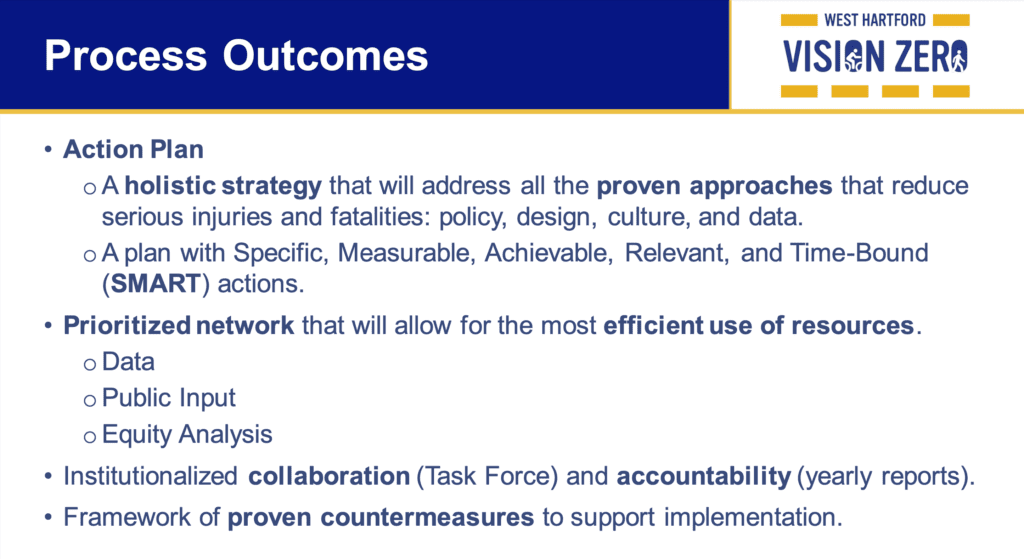
Screenshot
What’s happening right away?
Martin summarized the list of 72 projects that the town’s engineering and/or public works has prioritized to at least begin to implement in 2024. Most are related to crash response, speeding, and bicycle or pedestrian issues, he said.
In addition to creating a crash response team and implementing the SS4A speed enforcement camera grant, accessible pedestrian signal equipment will be upgraded. There are about 60 signals on town-owned roads and more that are on state roads, but 10 – including at the intersections of South Main with Boulevard, Ellsworth, and Elmfield – will be upgraded in 2024, Martin said.
Also on the list is a review and improvement where needed of lighting at crosswalks along Albany Avenue, from Sims Road (which runs past Target, behind the Bishops Corner shopping center) to Prospect Avenue. That includes the area where this month’s pedestrian fatality occurred.
Rectangular Rapid Flashing Beacons (RRFB) signals with high intensity crosswalks will be installed at 11 locations throughout town. “These are really enhancements to make motorists aware there’s a pedestrian,” Martin said. Several areas along Boulevard (Whiting Lane, Wardwell, and Lemay), as well as crosswalks on Sedgwick Road used by those walking to Sedgwick Middle School and Duffy Elementary School are on the list.
Retroreflective pavement markings will be added to five roadway segments, including South Main Street between Park/Sedgwick and Farmington Avenue and portions of Trout Brook Drive, Farmington Avenue, and New Park Avenue. Wider edge lines will be added to eight roadway segments, including many of those slated to received retroreflective pavement markings.
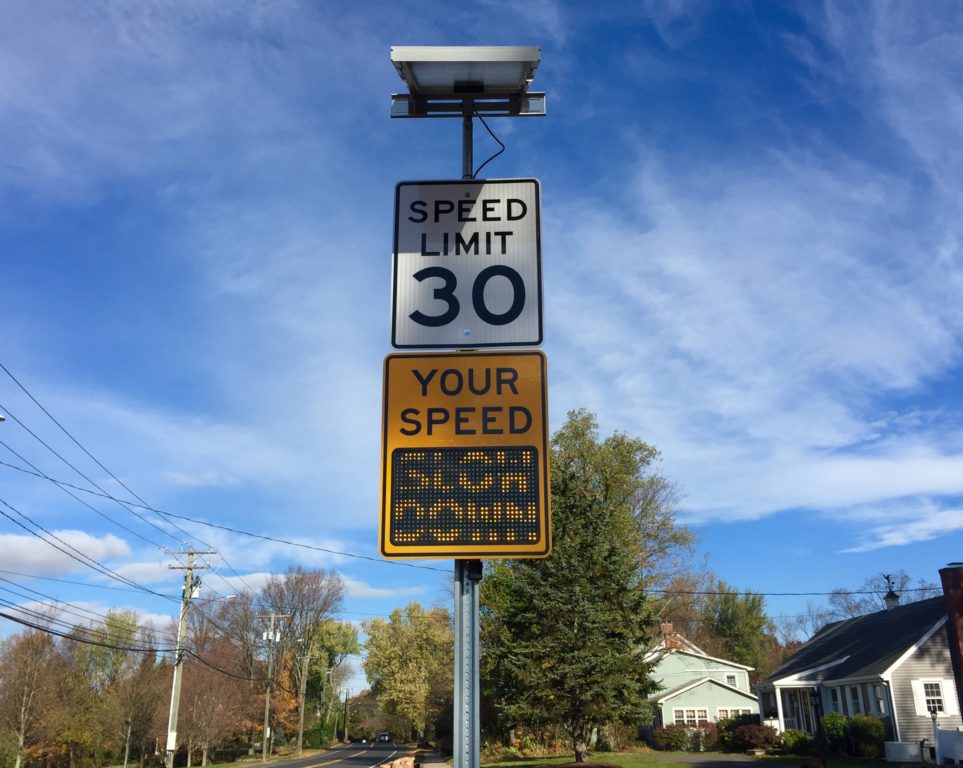
West Hartford has cameras throughout town that track speed, and will be relocating them to areas on the High Injury Network. Photo credit: Ronni Newton (we-ha.com file photo)
The town has 10 existing speed feedback signs, and those will be relocated to areas highlighted on the High Injury Network (HIN), Martin said. Also along the HIN, sightlines at intersections will be reviewed and if necessary changes made to parking and vegetation.
A project that the town had postponed last summer while awaiting completion of the Vision Zero Action Plan and a review of the bicycle facilities – the creation of bicycle lanes on Boulevard between Mountain Road and South Main Street – is on the list of projects for implementation in 2024.
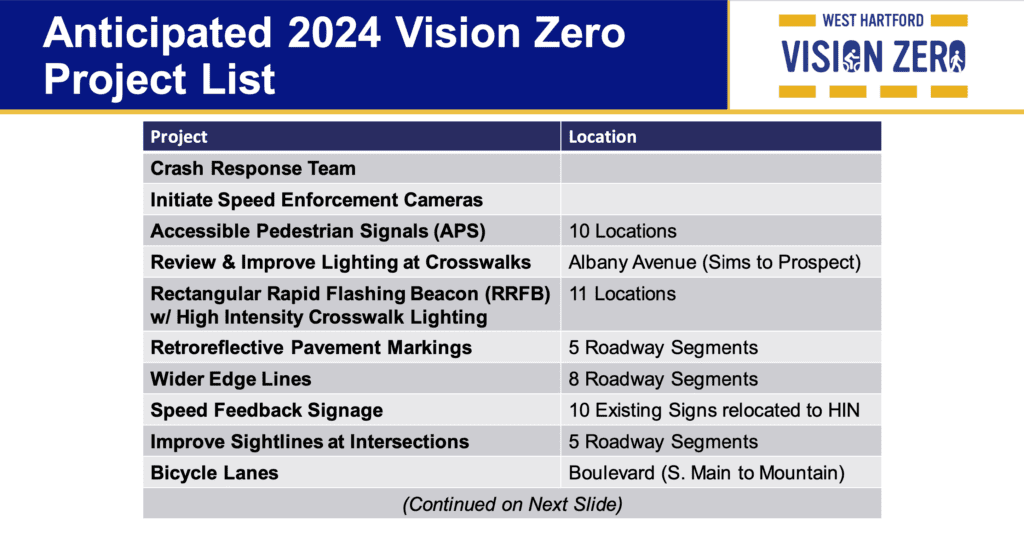
Screenshot
The town will be working with the Connecticut Department of Transportation to conduct a road safety audit of Albany Avenue – which is a state road – between North Main Street and Steele Road, Martin said.
The addition of dynamic no-turn-on-red signage (NTOR) “seems like a slam dunk,” Martin said, but could cause traffic issues elsewhere. These are blank signs that will illuminate when a pedestrian pushes the crosswalk button, and are very noticeable to drivers. Four locations have been identified for the installation of these dynamic NTOR signs including North Main Street at Asylum Avenue, Park Road at Trout Brook Drive, Farmington Avenue at Trout Brook Drive, and Farmington Avenue at Mountain Road.
Martin said specific locations have not been identified, but the addition of raised crosswalks will be reviewed along Boulevard and Fern Street.
Also planned is the addition of centerline rumble strips on Bloomfield Road (Route 189), and flashing stop signs will be installed at the intersection of Wardwell Road with Boulevard.
Various locations are slated for the addition of curve warning signage, including a stretch of South Main Street near Pebblebrook where two recent crashes in December alone have severed utility poles.
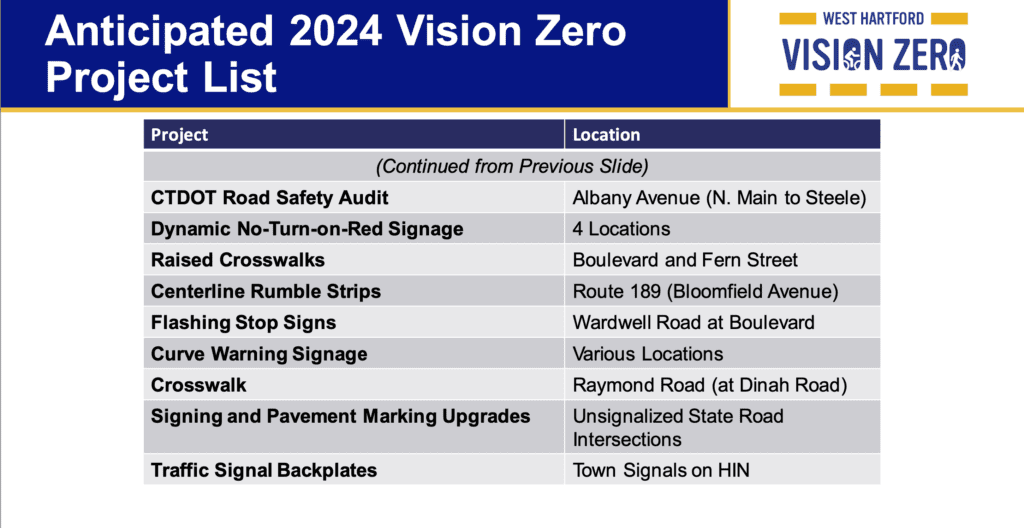
Screenshot
The town will also be installing a new crosswalk on Raymond Road at Dinah Road, where pedestrians often cross from Whole Foods to Blue Back Square, Martin said.
Signage and pavement markings will be upgraded at un-signalized state road intersections such as several locations along New Britain Avenue (Route 173) in Elmwood and on North Main Street (Route 218), as well as on Albany Avenue (Route 44).
Also on the list are the installation of traffic signal backplates on roadways included on the HIN. The shields help with sun glare, and have reflective strips on them, Martin said. Martin said the use of the backplates has received a lot of positive feedback from older motorists.
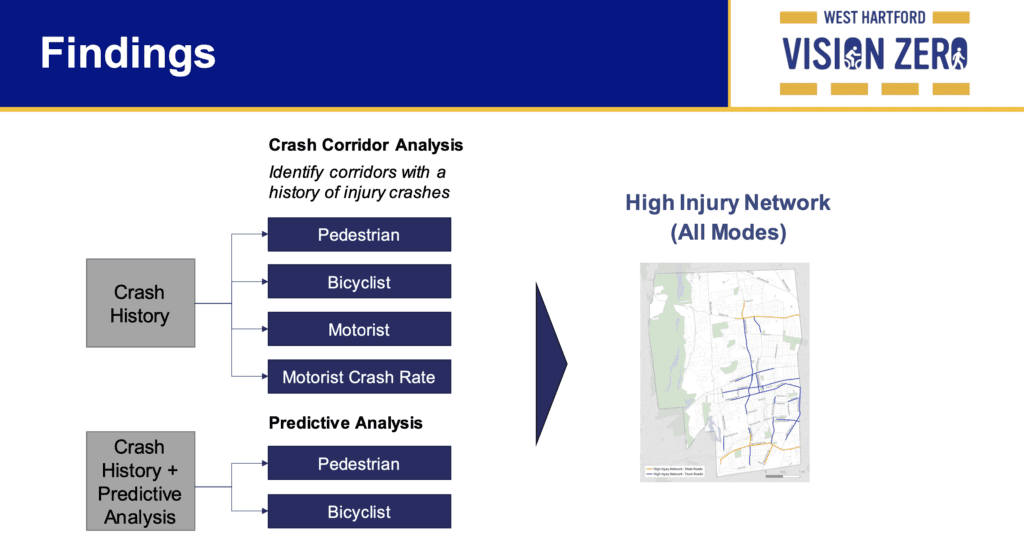
Presentation from the Vision Zero Task force regarding West Hartford’s High Injury Network (HIN)
“Nobody wants this implementation done more than the elected officials on this meeting,” Mayor Shari Cantor said. She said when the town first started the process of Vision Zero, “I wanted things done tomorrow,” but she understands that’s not the way to approach the problems. “It’s systemic … there’s a big picture,” she said, noting that there are many different pieces, the town doesn’t control all of the roads, and data needs to be provided to residents as well as to obtain funding for many of the elements of the plan.
“This is life and death … we are all emotional and driven by wanting to make our community better,” said Cantor. And it’s a problem not just locally, but nationally with speeding and distracted driving. “We get the urgency of this. I think this is the right framework to accomplish this process,” she said.
The community is invited to review and provide input prior to the finalization of the Vision Zero Action Plan. Comments can be emailed to [email protected] and should be submitted by Jan. 26, Martin said. The task force will be reconvening to discuss the final updates, and Martin said he hopes to have that completed by early February. The plan will then be brought back to CPED, and submitted to the Town Council, prior to implementation.
The draft of the Vision Zero Action Plan, which can be viewed via this link or the PDF below, is a “living document” that is being finalized in its initial iteration but will continue to be updated, Ledwith said. Change will be incorporated as needed, and a Vision Zero Advisory Committee will be established, by the end of January, to add another element of accountability and to work with staff “to be sure we do what we say we are going to do.” .
Like what you see here? Click here to subscribe to We-Ha’s newsletter so you’ll always be in the know about what’s happening in West Hartford! Click the blue button below to become a supporter of We-Ha.com and our efforts to continue producing quality journalism.
 Loading...
Loading...



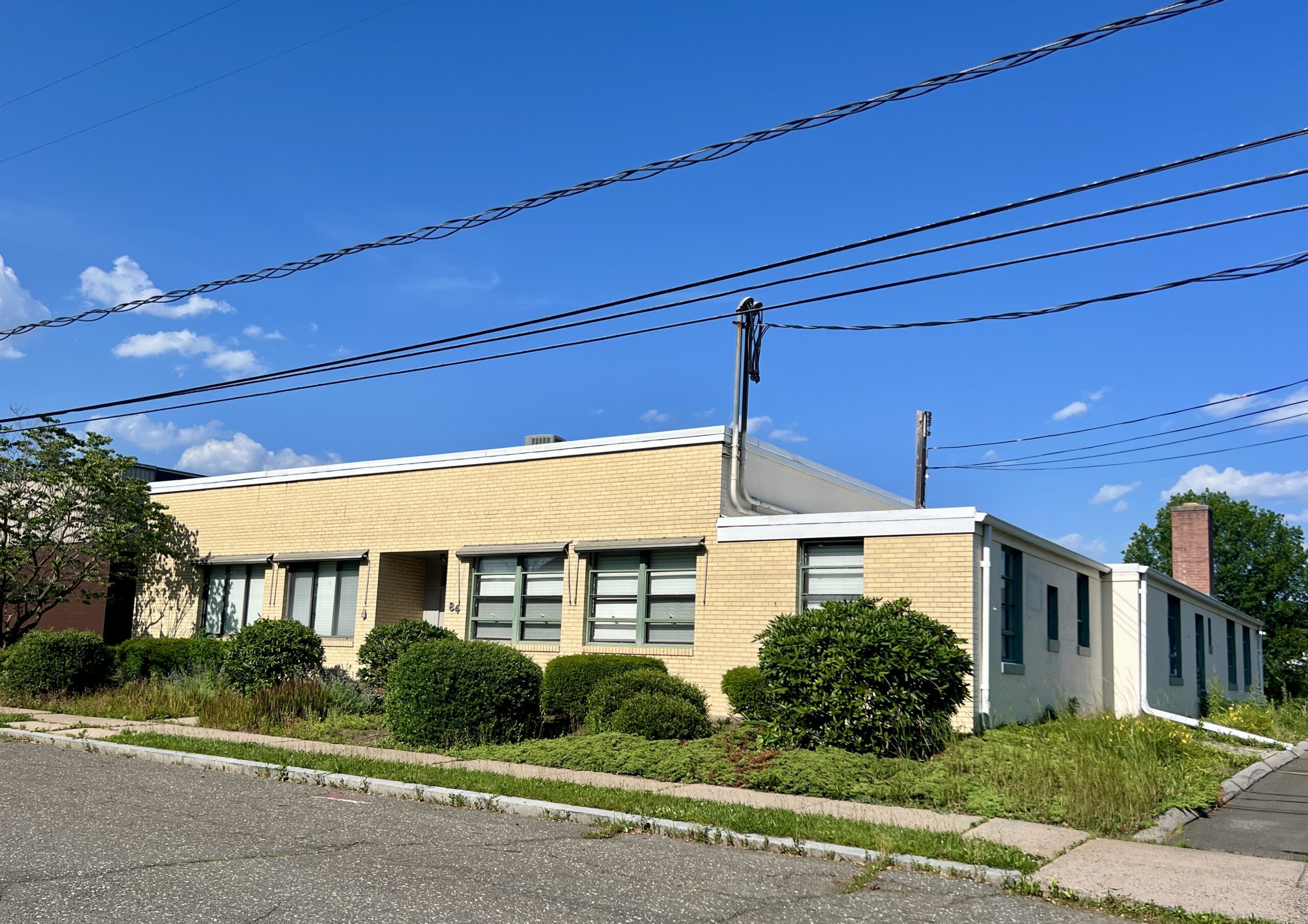
I don’t see pot hole repairs on the quick list
[…] Town Council’s Community Planning and Economic Development Committee (CPED) reviewed the draft at …, and final updates were discussed on Monday. The document, however, will not be static but rather […]